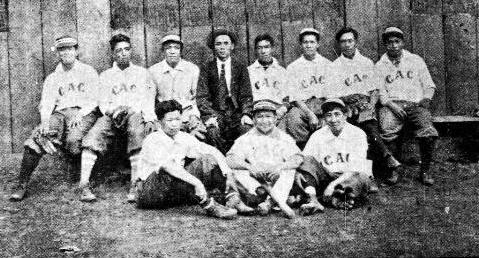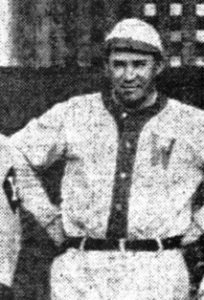Vernon Ayau became professional baseball’s first player of Chinese descent when he appeared briefly in the Northwest League in 1917.
But he was the not the first Chinese player a West Coast team attempted to sign. Two years earlier, Walter McCredie of the Portland Beavers tried to bring one Ayau’s teammates with the Chinese Athletic Club of Honolulu to the Pacific Coast League.
Fong Lang Akana was born in Hawaii in 1889 to a Chinese father and Hawaiian mother.
In the winter of 1914, McCredie announced that he had signed Akana. The (Portland) Oregonian said:
“Akana is a big, rangy fellow and bats left-handed. He weighs about 180 pounds, according to the dope given to Mack.”
The Oregon Daily Journal said he was 5’ 10” and quoted Bert Lowry, the sports editor at The Honolulu Commercial Advertiser:
“He swings from the left side and hits the ball hard at all times, Akana is well-educated, has pleasing manners and is willing to learn.”
Two former major leaguers Jack Bliss and Justin “Mike” Fitzgerald, barnstorming with Pacific Coast Leaguers in Hawaii, were impressed with Akana. Bliss said he was a great fielder who “had eyes all over his head.” Fitzgerald said:
“He is a good fielder and very fast. He is by far the best player in the islands.”
One additional observation from Lowry and Fitzgerald foretold that there would be trouble ahead:
Lowery: “He is a bit dark.”
Fitzgerald: “There is only one thing against him—he is very dark.”
McCredie told The Daily Journal that Akana would likely join the club at their Fresno, California training camp in the spring, the paper noted:
“Cubans, Indians, Poles and Italians have made good in baseball, but no Chinese or Japanese has yet won his spangles.”
It took less than a month for the plan to bring Akana to Portland to begin to fall apart.
The San Francisco Chronicle, while getting Akana’s name and position wrong, reported that:
“Portland players won’t play with a Chinese.”
The Honolulu Star-Bulletin said:
“Narrow racial prejudices, or possibly the fear that if the bars are let down someone will lose his regular job, threatens to work a grave injustice to Lang Akana.”
In late December, McCredie was ready to bend to the pressure, telling Roscoe Fawcett the sports editor of The Oregonian:
“His skin’s too dark…The Coast Leaguers who played at Honolulu on that recent barnstorming trip came back vowing boycott. I have received a couple of letters from players telling me Akana is as dark as Jack Johnson, so I guess I will have to give him a release.”
Pitcher “Seattle” Bill James, who also played against Akana in Hawaii, disputed the account that players were refusing to play with Akana, telling The Oregonian:
“I don’t think any ballplayer will object to playing on the same team as him. But he might have some trouble around the hotels. He is not black like a negro, more sepia colored—and his hair is straight.”
But in January, McCredie, who was by far the most progressive PCL magnates on the issue of race, switched direction, and vowed to keep Akana when Fawcett showed him a photograph of the outfielder:
“Dark or not dark, we’ll have Lang Akana report to us at Fresno…This photograph shows him to be extremely dark-skinned…(PCL umpire) Jack McCarthy saw him at Honolulu this winter and says Lang is just as white as most ballplayers after they have been out all summer in the sunshine.
“He doesn’t look any blacker than Barney Joy, who used to pitch for San Francisco.”
Apparently, McCredie found a way out without explicitly saying he refused to put a Chinese player on his club. Shortly before the Beavers headed to California, The Oregonian said:
“The Hawaiian, Akana, will not be considered unless he pays his own expenses to the spring camp at Fresno.”
The paper had said earlier that it would cost $175 to bring Akana over from Hawaii. Akana, whose father was a doctor, and whose family, according to several accounts were “wealthy,” likely could afford the cost of transportation. So, it is unknown whether he refused to pay for his own way or if the paper’s account was incorrect.
The Beavers went to California and started the season without Akana, but there was still talk of his joining the team. In May, The Honolulu Star-Bulletin said McCredie was still considering adding Akana to the roster:
“Portland is wavering between the first and second division…’What we need here are bat artists,’ writes the sporting editor (Fawcett) of The Oregonian to a Honolulan…Naturally, Lang is watching the Portland field from a distance; Manager Mac has not made good and Lang is playing the ‘watchful waiting’ polity to perfection.”
—
“Summed up, the situation now is: if Portland can gain a foothold in the Coast race within the next month or six weeks, it is probable that Akana will celebrate the Fourth of July and Christmas in Honolulu, if not then a demand for strengthening the team with a few good hitters will be forthcoming…’McCredie is silent on the Akana contract,’ (Fawcett) continued, ‘and I think that the Hawaiian-Chinese’s chances to play with the Beavers are good, unless Portland takes a sudden leap upward in the percentage column soon.”
The prediction was wrong. Portland struggled all season, finishing in last place with a 78-116 record, but the call never went out to Hawaii for Akana to join the team.
McCredie finally saw Akana in person two years later when he brought the Beavers to Honolulu for spring training. Fawcett said in The Oregonian that “Akana played left field and did not show up particularly well, owing it is said, that he had played little ball for several months.”
Akana continued to play in Honolulu—interrupted by service in the Hawaii National Guard in 1917—into the 1920s, but was “Too dark” to ever appear in a professional game.
Biographical notes: Some sources, including his Hawaii Birth and Christening (B&C) record list his name as Lan rather than Lang, the same B&C record lists his complete name as C. Fong Lan Akana. Several sources, including the B&C record list his date of birth as April 15, 1890, several others, including his WWI and WWII Draft Registrations list the date of birth as April 15, 1889.












